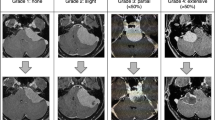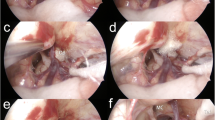Abstract
Introduction
Cellulose porous beads (CPBs) are exceptionally uniform in size and nonabsorbable and they provide highly effective tumor devascularization. The risk of cranial nerve palsy must not be overlooked when embolization with CPBs is considered in meningioma patients. We attempted to identify patients at risk of cranial nerve palsy after meningioma embolization.
Methods
Prior to preoperative superselective embolization with 200 μm diameter CPBs, 141 patients with meningioma underwent provocation test with lidocaine and amytal. They were divided into two groups on the basis of whether they were or were not considered eligible for embolization. We evaluated the differences between the two groups with respect to tumor anatomy, angiographic findings, and clinical presentation and recorded complications associated with the embolization of the meningioma.
Results
Of the 141 patients, 128 underwent CPB embolization (group 2); 13 were not embolized because their provocation test results were positive (group 1, n = 11) or because they showed vasospasm (n = 2). Group 1 patients had meningioma in the cavernous sinus or petroclival region. Characteristically, the feeders were of middle meningeal artery origin and exhibited a posteromedial course toward the petrous apex or cavernous sinus. In group 2 patients the middle meningeal artery was the feeder, but it lacked branches coursing posteromedially. Three of these patients experienced complications which included intratumoral hemorrhage (n = 2) and post-embolization hearing disturbance (n = 1).
Conclusion
Patients with meningioma whose tumor-feeding arteries run posteromedially toward the petrous apex or cavernous sinus are at increased risk of post-embolization cranial nerve palsy. Appropriate protocols, including lidocaine and amytal provocation tests, may reduce the risk of complications after CPB embolization of the external carotid territory in this group of patients.



Similar content being viewed by others
References
Hamada J, Kai Y, Nagahiro S, Hashimoto N, Iwata H (1996) Embolization with cellulose porous beads. II: Clinical trial. AJNR Am J Neuroradiol 17:1901–1906
Hamada J, Ushio Y, Kazekawa K, Tsukahara T, Hashimoto N, Iwata H (1996) Embolization with cellulose porous beads. I: An experimental study. AJNR Am J Neuroradiol 17:1895–1899
Flandroy P, Grandfils C, Collignon J, Thibaut A, Nihant N, Barbette S, Jerome R, Teyssie P (1990) (D, L)polylactide microspheres as embolic agent. A preliminary study. Neuroradiology 32:311–315
Latchaw RE (1993) Preoperative intracranial meningioma embolization: technical considerations affecting the risk-to-benefit ratio. AJNR Am J Neuroradiol 14:583–586
Wakhloo AK, Juengling FD, Van VV, Schumacher M, Hennig J, Schwechheimer K (1993) Extended preoperative polyvinyl alcohol microembolization of intracranial meningiomas: assessment of two embolization techniques. AJNR Am J Neuroradiol 14:571–582
Berenstein A, Da G (1982) Convenient preparation of ready-to-use particles in polyvinyl alcohol form suspension for embolization. Radiology 145:846–849
Herrera M, Rysavy J, Kotula F, Rusnak B, Castaneda-Zuniga WR, Amplatz K (1982) Ivalon shavings: technical considerations of a new embolic agent. Radiology 144:638–640
Szwarc IA, Carrasco CH, Wallace S, Richli W (1986) Radiopaque suspension of polyvinyl alcohol foam for embolization. AJR Am J Roentgenol 146:591–592
Beaujeux R, Laurent A, Wassef M, Casasco A, Gobin YP, Aymard A, Rufenacht D, Merland JJ (1996) Trisacryl gelatin microspheres for therapeutic embolization, II: Preliminary clinical evaluation in tumors and arteriovenous malformations. AJNR Am J Neuroradiol 17:541–548
Dion JE, Rankin RN, Vinuela F, Fox AJ, Wallace AC, Mervart M (1986) Dextran microsphere embolization: experimental and clinical experience with radiologic-pathologic correlation. Work in progress. Radiology 160:717–721
Gu WZ, Link DP, Tesluk H, Blashka K (1992) Experimental renal embolization: preliminary results with polyacrylonitrile-based multiblock copolymers. J Vasc Interv Radiol 3:119–125
Horak D, Svec F, Kalal J, Adamyan AA, Volynskii YD, Voronkova OS, Kokov LS, Gumargalieva KZ (1986) Hydrogels in endovascular embolization. II. Clinical use of spherical particles. Biomaterials 7:467–470
Horak D, Svec F, Kalal J, Gumargalieva K, Adamyan A, Skuba N, Titova M, Trostenyuk N (1986) Hydrogels in endovascular embolization. I. Spherical particles of poly(2-hydroxyethyl methacrylate) and their medico-biological properties. Biomaterials 7:188–192
Laurent A, Beaujeux R, Wassef M, Rufenacht D, Boschetti E, Merland JJ (1996) Trisacryl gelatin microspheres for therapeutic embolization. I: Development and in vitro evaluation. AJNR Am J Neuroradiol 17:533–540
Russell EJ, Levy JM (1987) Direct catheter redirection of a symptomatic errant intracranial silastic sphere embolus. Radiology 165:631–633
Terada T, Nakamura Y, Tsuura M, Miyamoto K, Nakai K, Nishiguchi T, Hayashi S, Komai N (1992) MRI changes in embolized meningiomas. Neuroradiology 34:162–167
Turjman F, Massoud TF, Vinters HV, Ji C, Tardy M, Guglielmi G, Vinuela F (1995) Collagen microbeads: experimental evaluation of an embolic agent in the rete mirabile of the swine. AJNR Am J Neuroradiol 16:1031–1036
Kai Y, Hamada J, Morioka M, Yano S, Todaka T, Ushio Y (2002) Appropriate interval between embolization and surgery in patients with meningioma. AJNR Am J Neuroradiol 23:139–142
Kai Y, Hamada JI, Morioka M, Yano S, Nakamura H, Makino K, Mizuno T, Takeshima H, Kuratsu JI (2006) Clinical evaluation of cellulose porous beads for the therapeutic embolization of meningiomas. AJNR Am J Neuroradiol 27:1146–1150
Matsumoto S (1987) Peritumoral and intratumoral hemorrhage after gelatin sponge embolization of malignant meningioma: case report. Neurosurgery 21:944–946
Deveikis JP (1996) Sequential injections of amobarbital sodium and lidocaine for provocative neurologic testing in the external carotid circulation. AJNR Am J Neuroradiol 17:1143–1147
Handa J, Nakasu S, Matsuda I (1980) Facial nerve palsy following therapeutic embolization. Surg Neurol 14:377–380
Horton JA, Kerber CW (1986) Lidocaine injection into external carotid branches: provocative test to preserve cranial nerve function in therapeutic embolization. AJNR Am J Neuroradiol 7:105–108
Lasjaunias P, Doyon D (1978) The ascending pharyngeal artery and the blood supply of the lower cranial nerves. J Neuroradiol 5:287–301
Minatogawa T, Kumoi T, Hosomi H, Kokan T (1980) The blood supply of the facial nerve in the human temporal bone. Auris Nasus Larynx 7:7–18
Calcaterra TC, Rand RW, Bentson JR (1976) Ischemic paralysis of the facial nerve: a possible etiologic factor in Bell’s palsy. Laryngoscope 86:92–97
Jack CR Jr, Forbes G, Dewanjee MK, Brown ML, Earnest FT (1985) Polyvinyl alcohol sponge for embolotherapy: particle size and morphology. AJNR Am J Neuroradiol 6:595–597
Guyomard S, Darbord JC (1985) Quantitative determination of bacterial endotoxins by the chromogenic limulus method: critical analysis and study of interactions between 3 divalent cations. Ann Inst Pasteur Microbiol 136B:49–55
Luessenhop AJ, Spence WT (1960) Artificial embolization of cerebral arteries. Report of use in a case of arteriovenous malformation. JAMA 172:1153–1155
Rao VR, Ravimandalam K, Jayakrishnan A, Thanoo BC, Radhakrishnan VV, Gupta AK, Kumar S, Joseph S, Unni M, Rao AS (1991) Hydrolysed microspheres from cross-linked polymethyl methacrylate (Hydrogel). A new embolic material for interventional neuroradiology. J Neuroradiol 18:61–69
Repa I, Moradian GP, Dehner LP, Tadavarthy SM, Hunter DW, Castaneda ZW, Wright GB, Katkov H, Johnson P, Chrenka B (1989) Mortalities associated with use of a commercial suspension of polyvinyl alcohol. Radiology 170:395–399
Conflict of interest statement
We declare that we have no conflict of interest.
Author information
Authors and Affiliations
Corresponding author
Rights and permissions
About this article
Cite this article
Kai, Y., Hamada, Ji., Morioka, M. et al. Preoperative cellulose porous beads for therapeutic embolization of meningioma: provocation test and technical considerations. Neuroradiology 49, 437–443 (2007). https://doi.org/10.1007/s00234-007-0218-0
Received:
Accepted:
Published:
Issue Date:
DOI: https://doi.org/10.1007/s00234-007-0218-0




